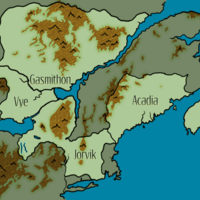Locus: Outbuildings - Part III
The tables from part I and part II of this series were used to create two sample estates, Nornodd and Lockewick. Each was given four outbuildings with two traits each.
The presence or qualities of a single outbuilding can affect the role or nature of the entire estate and suggest its history as well.
Next week, part IV, more sample estates.
Nornodd
This Gasmith estate pastures, slaughters, and renders old ghasts. It’s a property of the Bouchol Clan which suffers an unpopular reputation for doing unpleasant but needed work, so is constantly understaffed.
The main house is a severe fieldstone and timber construction. Most of the time only the lower floor is in use, with hands rattling around the numerous old empty rooms. The barn is built similarly and every stall is usually filled. Attached at its rear is a deep root cellar full of potatoes, carrots, and sunchokes - potato vines from roots long lost wind up the stones, and yellow flowers bloom among them.
Adjunct the barn piles of stone trace a rough sketch of what used to be servants’ quarters. As the estate’s purpose shifted and the main house became opener, these were slowly abandoned and now serve only as occasional temporary shelter for ghasts or a mysterious playground for the keepers’ children. Small coins and items are still uncovered here from time to time.
Nornodd sits alongside a slow but wide river. Where the river enters, there is a low-slung boathouse with several rowboats tied inside. Numerous lamps burn dimly here at night as it’s a favored place of the staff to gather and recount the day over tea and kvass. In all but the coldest months though they must burn wet reeds in a hammered brass fire bowl, for the river spawns great clouds of mosquitoes.
At the far end of the river, removed from the pasture and the main yard, is the tannery. At some point in the past this building was a forge, but now its vats are used to render dead ghasts down to tallow, and its beams are hung with drying hides. Unusable bits and chemicals are thrown to the river. It’s this building that gives the whole estate purpose and shame.
Rolls
- 53 - Root Cellar
- 31 - Dedicated to 4: Horses or ghasts.
- 61 - Overgrown
- 16 - Boathouse
- 51 - Infested
- 13 - Cozy
- 51 - Quarters
- 78 - Ruined
- 08 - Austere
- 86 - Tannery
- 38 - Distant
- 78 - Repurposed from 25: Forge
Lockewick
Nestled in the heart of Charlotte, the island realm of Acadia, Lockewick is an ancient holding of its aristocracy. The main house is four stories of intricate brickwork, tall but narrow, bordering on towerlike, and topped with three spires. There is no barn - this is not a working farm in most senses. Instead a wide, green yard stretches in front of the house, dotted with patios, fountains, and hundreds of ducks.
Behind the house a large brick summer kitchen smokes. Each of the many rooms here is dedicated to a specific aspect or organ of the duck, and each presided over by its own fussing chef. A visitor is likely handed a cup of tea or small treat before being gently escorted to the next room to become someone else’s problem, and in short order finds themselves on the back porch with a delicate lunch and no idea what just happened.
Herb gardens stretch out from the sides of the kitchen and house, where ducks waddle and nibble at leisure. They are carried from their final trip to the kitchen in fine-cast clay pots to an imposing stone structure which peeps from a nearby grove of apple trees, the Lockewick Dome. Here they are preserved indefinitely by freezing air, and slowly infused by the surrounding blossoms and herbs. Every year Lockewick holds an enormous and highly selective garden party during which much of the confit from the icehouse is consumed, and the remainder is sold to brokers who distribute it across the Lands as a delicacy of surpassing taste and expense.
The pots used for the confit are crafted on the grounds by patronized artists and add to its grandeur considerably. A lofty building on a small hill overlooking the grounds provides them ample light and inspiration. However, lately several works have been found smashed, and one of the potters reported hearing growling coming from beneath his cottage.
At the far edge of largest herb garden is a quaint potting shed which would be considered a mansion in many other contexts. Intimate guests are often entertained and housed here, but many complain the next day of queer dreams or lost jewels. Indeed, a sprite calling itself Reinard has been living here for several generations, playing bright mischief and telling old stories to children and sleeping adults.
Rolls
- 45 - Potting Shed
- 70 - Quarters
- 42 - Fey
- 37 - Icehouse
- 28 - Dedicated to 1-2: Chickens or ducks
- 93 - Superior
- 85 - Summer Kitchen
- 10 - Cozy
- 14 - Cramped
- 78 - Studio
- 04 - Airy
- 53 - Lair
